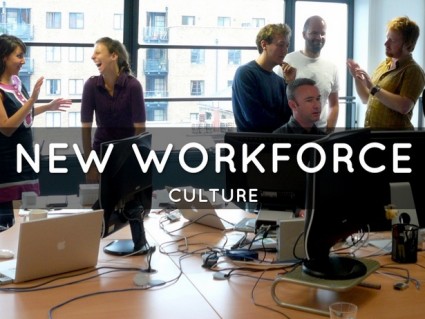The average cost to a company of replacing an employee is one fifth of that employee’s annual salary. And positions that require more complex skills to re-fill are even more costly. It is increasingly becoming more competitive for top talent right now, especially in the globalized market where humans are a company’s greatest asset. For a company with a high employee turnover rate, this can be an enormous drain on the finances.
One way to counter the churn is of course to pay market value or higher, but if another company is willing to pay out double the amount you’ve offered to poach a top employee, then there has to be something in your company culture that will make your star employees want to stay with you.
Why Culture Can Trump Compensation
Sure, we all need money to pay the bills, but we demand the same for a fulfilling place to work. The new workforce thrives off culture, and a large proportion of these people are Gen Y’s who will “transform the whole attitude toward life-work balance.” explains Joyce Gioia. “I intentionally said ‘life’ first, because this generation puts life first.”
The are a number of factors involved in creating the kind of culture that will keep the rising star talent knocking at your door and sticking around for the long haul:
- Feedback. Younger workers, in a reflection of the amount of feedback they get at home and school are expecting more feedback in the workplace than Gen X or Baby Boomers ever did.
- Decentralized workspaces. The immense improvements in mobile technology in recent years mean that it’s easier than ever to work in a non-office environment: at home, in the cafe, in a public park.
- Flexibility. Companies like Google have thrown out the traditional idea of the staid working environment and introduced ways of working that provide flexibility and ways to strengthen employees’ creative muscles. These companies are proving a great influence on the rest of us.
- Security. Job security is becoming less of a reason to take a job. Though still important, it is no longer a given as it was in our parents’ and grandparents’ generations.
- Globalization. The world becoming a smaller place meaning that star employees are finding it easier than ever to find a new job, whether that be at home or abroad.
So what does an employer have to do?
Encouraging a work-life balance is one way to create an environment that an employee will not want to sacrifice in pursuit of a larger wage.
This may seem easier for startups, but even larger corporations are attempting to embrace innovative ways of implementing a type of work place that would suite a newer generation. ROWE (Results Only Working Environment) where there are no set hours – employees simply need to meet their objectives in whatever time it takes them – gained a lot of media attention a few years back. When it was initially introduced in Best Buy, the control group who tried it out saw a 6% turnover rate compared to 11% in the group that didn’t take part. It held employees accountable to the outcome, not the time put into their work, and it worked to reduce churn!
Companies don’t need to go that far, however, to foster a better balance. Allowing working from home when needed, with flexible start and finish times, can be enough to make a position very attractive. Many of the more driven and motivated employees (top talent) find that they work more than the requisite 40 hour office job. And because they’re able to do so with flexibility, they don’t draw a black and white distinction between work and life which enables them to contribute more qualitatively and sometimes quantitatively. There is of course a balance to all of this. Google and Yahoo both have their reservations but as mentioned in that BBC article, some face time in the office is a possible compromise.
Regular communication and an environment where feedback is encouraged and valued between manager and employee is a key factor in making the worker feel valued and encourages them to “buy into” the company they work for. This has benefits for the employer in that they have a better handle on their employees’ state of mind as well as their level of productivity and efficiency, and for the employee because they can air their grievances as well as successes.
Mapping out a career path with the Gen Y employee and demonstrating to them that their contributions really do help the company to become great, will provide them with genuine motivation –and you and your company will be rewarded in return with loyalty (people tend to stay where they feel valued and worthwhile.) Respect and transparency are two key concepts that a modern employer should aim to provide.
That’s not all…
Training and development schemes are a great way to foster an attractive workplace culture. Take the Googlers-to-Googlers educational system, where one employee can teach any other about anything they’re interested in, be that a programming language, yoga or parenting.
And of course perks like free lunches, drinks after work, and team strategy retreats are worth investing in as they provide team-building opportunities as well as relaxation between bouts of hard work.
Keep your employees happy to keep them around (Click to Tweet)
You might not be the most cash-rich company in the world, but for much of GenY (and the rest of us) money isn’t the only motivation when it comes to staying in the same job for years. Provide a more inspiring and creative working environment and you’ll start to see your employee churn rate drop.
About the Author
David Hassell is a serial entrepreneur and CEO of 15Five, a software company focused on producing transparency and alignment in organizations through structured, efficient and effective communication practices. David has also been named The Most Connected Man You Don’t Know in Silicon Valley by Forbes.



Alli, Thanks for hosting this post by David and, David, thanks for an insightful article on company culture.
One of the key items to be included in the career path is education. In particular, I believe Gen Y is eager to learn and continue to grow. Through conferences, training, and other educational opportunities, organizational culture will need to embrace an aggressive and thought-provoking continuous learning plan. It will enable a better culture and empower teams to expand their knowledge and practical application of it.
Great points in your article. Thank you! Jon
Thanks, Jon! Great points. Continuous learning is critical… but not only on the fly but a learning plan ensures access to learning and ideas with a commitment to application too. Appreciate your exceptional blog on Gen Y too!
Jon, you’re welcome. And I completely agree. We’ve got a number of Gen Y folks working with us at 15Five and one of our core values is Always Be Learning and Growing. We often look at who we get to become as a result of the work we’re doing in addition to the results being produced.
Great list. I would add challenges. It’s hard to want to leave when you are “up to something” great.
Right on, Karin! Feels great to work on something meaty and meaningful. Thanks!
Karin, you are so right on. Thanks for that!